What is Content Writing? (2024 Guide for Beginners)
According to DemandSage, 43% of small businesses are also ready to invest more in content writing. What does this mean? Content writing has become more important than ever.
But what exactly is content writing, and how to write good content for your company’s blog?
Grab your cup of coffee, and let’s dive right in!
Table of Contents
- Key Takeaways:
- Content writing is creating written material for online platforms to educate, persuade, or entertain the audience.
- Content writing differs from copywriting, which focuses on persuading and driving immediate action.
- Types of content writing include blog posts, website copy, social media posts, eBooks, white papers, technical writing, and case studies.
- The content writing process involves planning, researching, writing, editing and proofreading, publishing and promoting, and monitoring and analyzing.
- To become a good content writer, one needs to learn content writing, specialize in a niche, understand the audience, master SEO, build a portfolio, join freelancing platforms, and more.
What is Content Writing?
Content writing is creating written material for online platforms to educate, persuade, or entertain the audience. This includes blog posts, articles, website copy, social media posts, etc.
Content writing focuses on driving traffic, increasing brand awareness, and educating the audience. For example, when you google ‘Unique hobbies around the world,’ you will see many posts covering this topic.
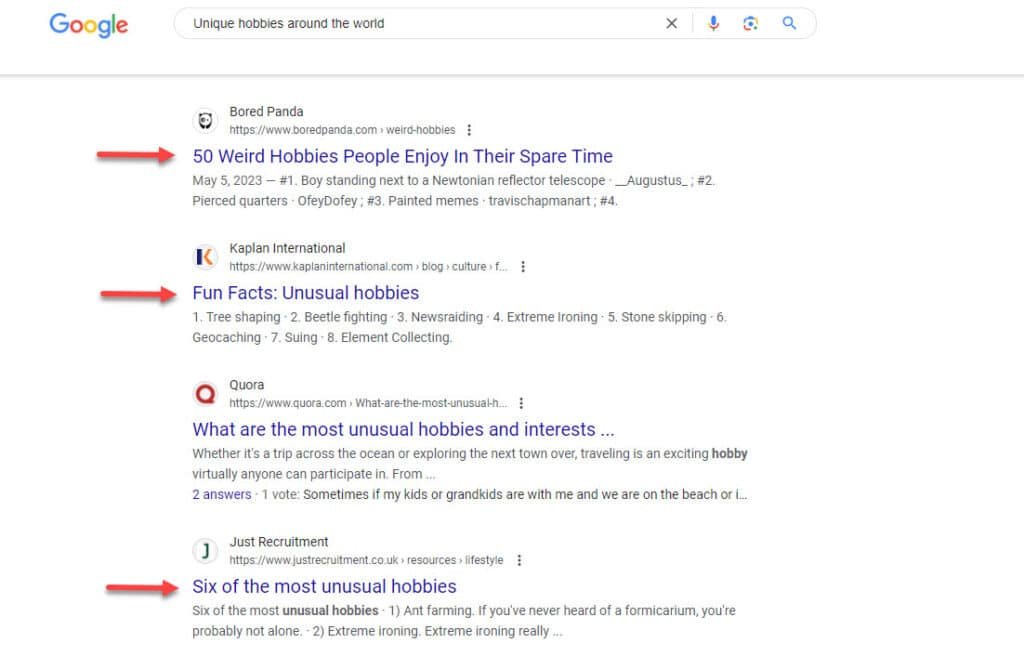
These posts were written by content writers to educate readers.
Content Writing vs Copywriting: What’s the Difference?
You’ve certainly seen the term “Copywriting” before and you might mistakenly think it’s the same as content writing. We need to understand the difference before we move on to the next section.
Content writing focuses on informing, educating, and entertaining the audience. It also builds trust. Copywriting, on the other hand, focuses on persuading and driving immediate action, like clicking a link or making a purchase.
Imagine a travel website promoting a tropical destination.
A content writer will write a blog post titled “Top 10 Hidden Beaches in Bali.” The copywriter, however, will create an ad copy with the headline “Escape to Paradise! Book Your Dream Bali Vacation Today and Save 20%!”
But, though there is a clear difference, do not be surprised to see content writing and copywriting used interchangeably.
What is AI Content Writing?
AI content writing is using AI tools to generate written content. You can use artificial intelligence to create blog posts on many topics, from news articles to listicles and how-to guides.
These AI tools can also write website copy like landing pages, about us pages, and FAQ sections.
Who Needs Content Writing Services?
Individuals, small businesses, and startups needing help creating website copy, blog posts, or social media content, may need content writing services. The same goes for larger companies seeking to outsource their content creation efforts.
In short, anyone who wants to attract and engage their target audience, or improve their search engine rankings often requires high-quality content.
Types of Content Writing
Now that we know what content writing is and who needs it, let’s look at a few content writing types.
Blog Posts
A blog post is a regularly updated article on a specific topic or niche and is typically 1500 to 2000 words. It informs, entertains, and engages readers. It also builds brand awareness and drives traffic to the website.
There are many blog post types, like how-to guides, listicles, news articles, opinion pieces, reviews, comparisons, case studies, checklists, etc. What you’re reading now is a blog post and the type is ‘guide.’ It’s guiding or teaching you everything about content writing.
Let’s take two examples and see how blog posts generate traffic and money for businesses.
Imagine you run a blog on productivity and want to write a blog post. You could write a listicle post like ‘10 best productivity tools to use in 2025.’ The first post ranking for the keyword ‘productivity tips’ gets at least 9500 visitors per month, and the traffic keeps increasing.
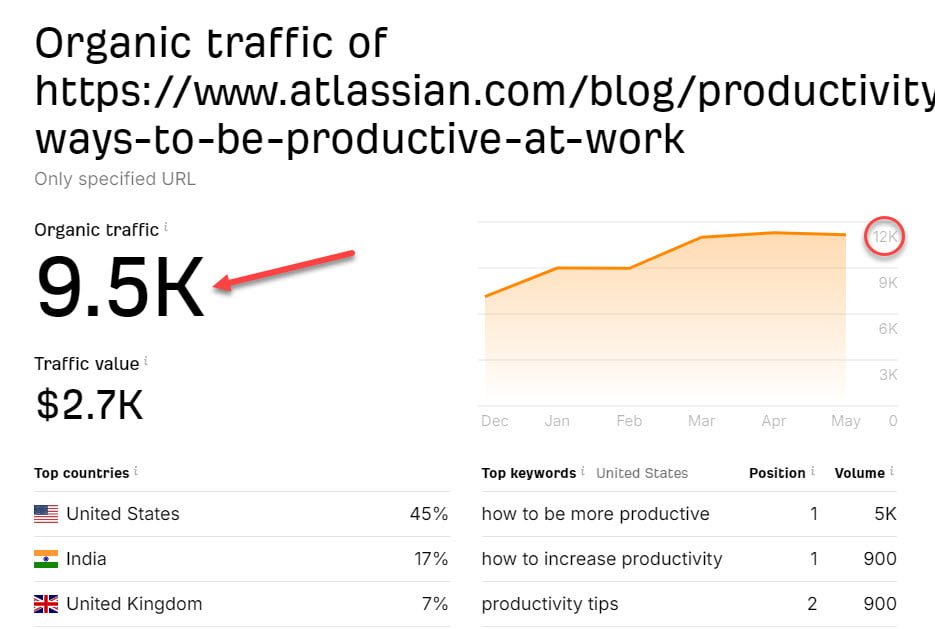
By writing this post, you could mention a few productive tools you’re affiliated with and earn a commission after sales. You could also add links to other relevant posts about productivity apps and books. These posts will also have affiliate links or your own products.
Now, imagine you are a small business or large company in the AI voice industry, for example. You could write a blog post like ’15 Best AI Voice Generators.’ The first post ranking for this keyword is estimated to get 7400 visitors per month, and it keeps increasing.
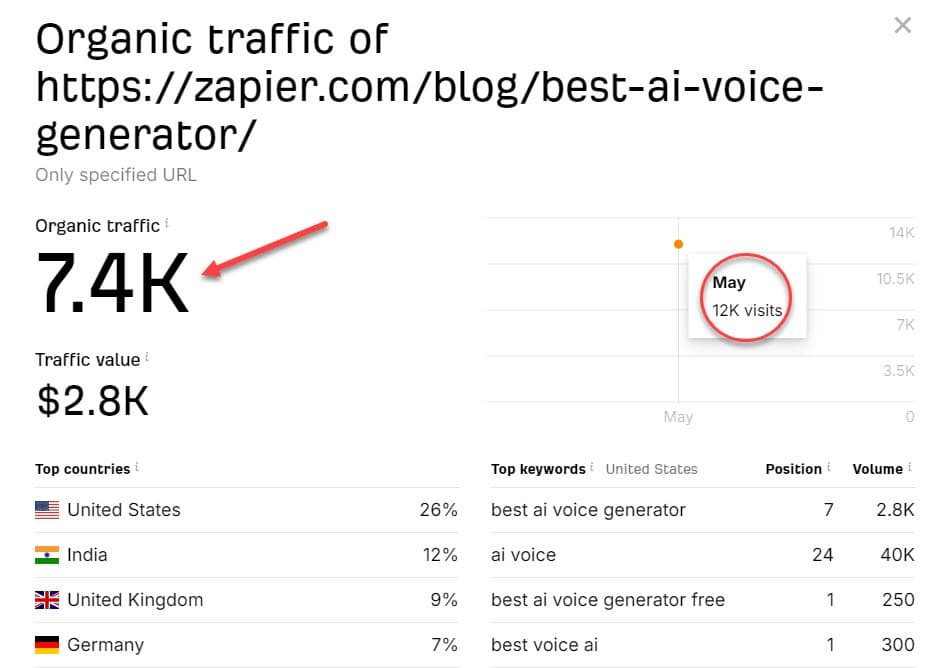
By ranking for this keyword, you can mention your tool first and thoroughly share its benefits and key features. This could potentially increase your leads and sales.
Now, this is easier said than done. A blog post doesn’t automatically rank on the first page of Google. There is always a lot of work behind. You need to find the right topics, and keywords, and research a lot. Finally, you need to craft the best content possible.
Blog content writing takes a lot of time.
A solution is to hire someone and train them to become a good content writer. But this also takes time. The best solution, however, is to use an agency like Rank Lyx and order high-quality content that is ready to publish and rank.
You won’t have to train anybody and you’ll always have content when you need it and where you need it.
Increase Your Website Traffic & Sales With Ready-To-Publish Content!
Boost your brand by creating interesting blog posts specifically crafted for your audience. Let our expert writers transform your ideas into engaging content that drives leads and sales.
Website Copy
Website copy is the words that welcome your customers, tell them about your products or services, and guide them on what to do next. This includes everything from the welcome message on your homepage to detailed product descriptions and those “Get Started” buttons.
Good website copy is easy to understand and makes visitors feel at home. It uses simple words and explains things clearly so anyone can understand your offer.
Smartlead’s hero section is a great example.

Your website copy also highlights why your products or services are special and how they can solve problems or make life easier. Any.do’s product page, for example, talks about setting due dates and reminders to make sure nothing important slips away.
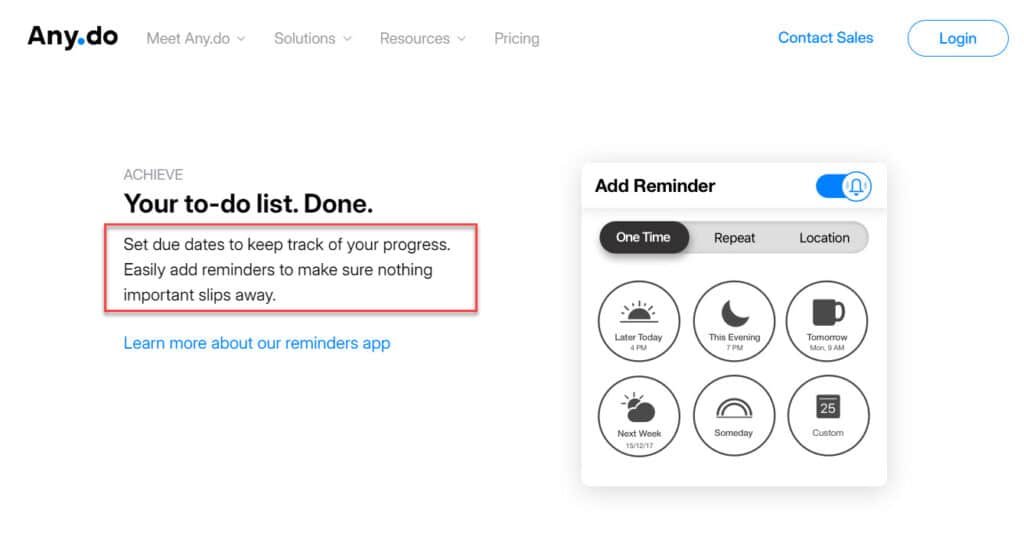
Social Media Posts
Social media posts are like conversations you have with your online community. They’re short, attention-grabbing messages designed to spark interest, encourage interaction, and keep your brand top-of-mind.
Imagine scrolling through your social media feed. The ones that stand out are visually appealing, use catchy language, and offer something of value, whether it’s a funny meme, a thought-provoking question, or a helpful tip.

Ebooks and White Papers
The next online content writing types are ebooks and white papers.
Ebooks are typically longer than blog posts and go deeper into a subject. They are more about providing comprehensive information and actionable advice. E-books often have a more casual tone and may include visual elements like images, charts, or infographics to improve the reading experience.
Businesses use ebooks for lead generation, thought leadership (to establish themselves as an authority in their industry), and customer education.
The other type is White Paper. It’s more formal and research-based documents. It’s typically written for a professional audience and focuses on presenting data, analysis, and solutions to complex problems.
It’s used for lead generation, thought leadership, and decision-making.
Technical Writing
Technical writing is a specialized form of content writing that focuses on explaining complex topics, processes, or products clearly and concisely. It translates jargon into everyday language that everyone can understand.
A good example is Microsoft’s guide on troubleshooting wi-fi connection issues.
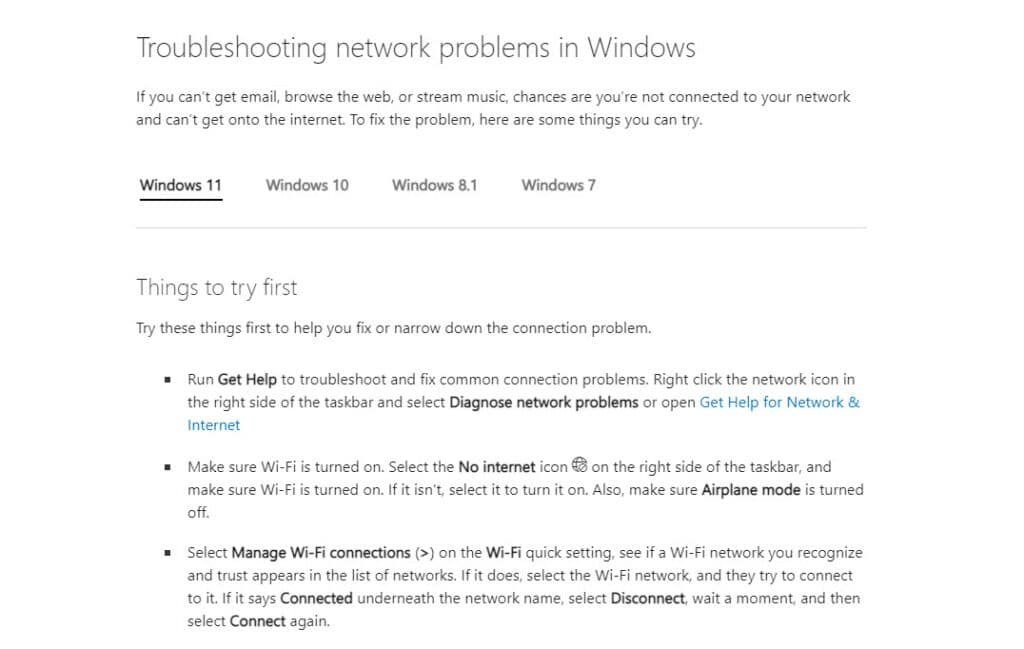
Technical writing is the user guide for a software program. It’s the documentation that helps someone understand how something works, how to use it, or how to troubleshoot problems.
Case Studies
Case studies are mini success stories that demonstrate the real-world impact of your product or service. They showcase how you’ve helped a specific customer overcome a challenge, achieve a goal, or improve their situation.
They are testimonials on steroids. Instead of just a quick quote praising your product, case studies go deeper into the details.
Case studies usually include:
- The challenge: The problem the customer was facing
- The solution: How your product or service addresses the challenge
- The results: The specific outcomes the customer achieved
- The testimonial: What the customer had to say about their experience
A good website content writer will craft a case study that builds credibility, attracts new customers, and strengthens relationships with existing customers.
Content Writing Process
Now, how to write content?
The content writing process involves:
- planning
- researching
- writing
- editing and proofreading
- publishing and promoting
- and monitoring and analyzing.
Let’s cover each of them in detail.
1. Plan Your Content
Planning your content is like building a house. You wouldn’t start construction without blueprints, right? Planning is where you figure out what you want to build (your goals), who you’re building it for (your audience), and how you’ll make it look amazing (your approach).
If you skip planning, you might end up with a house that doesn’t make sense, isn’t comfortable to live in, or just plain falls apart. The same goes for content – without planning, it might not be interesting, won’t connect with the right people, or simply won’t work.
1.1 Define Your Goals
What do you want your content to achieve? Are you looking to increase website traffic, generate leads, educate your audience, or build brand awareness? Your goals will guide your content creation.
1.2 Identify Your Target Audience
Next, you need to identify your target audience (aka who you’re writing for).
What are their interests, pain points, and preferences? Understanding your audience will help you write content that solves their problems.
For example, let’s assume I want to write a blog post about solar energy. This is what my planning stage will look like:
- Title: What is Solar Energy?
- Goal: To educate potential customers about the benefits of using solar energy for their homes.
- Purpose: To inform and educate.
- Target audience: Homeowners interested in sustainable energy solutions.
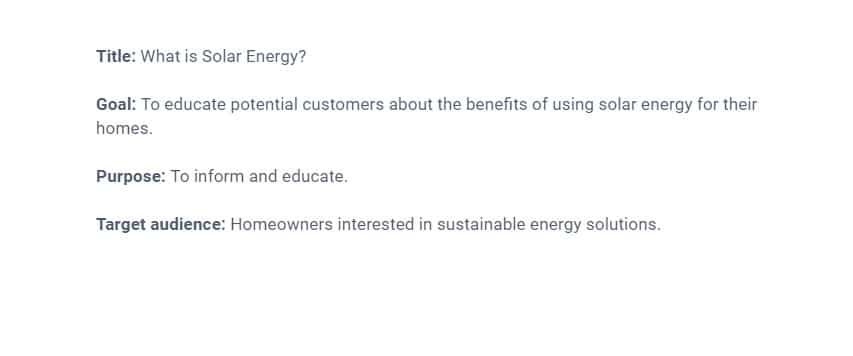
2. Research
The next step is to research your topic. First, use a keyword research tool to understand the traffic potential and relevant keywords. There are many great tools like Ahrefs and Semrush, but they are not cheap.
However, you can use Ahrefs’ free keyword generator. Add your keyword, select your audience location, and search. In my case, I searched for ‘What is solar energy.’

Thanks to this research, I found some keywords my audience is interested in, like: what is solar energy used for, how it works, and what are the advantages and disadvantages. This will allow me to create a good outline (more about this later).
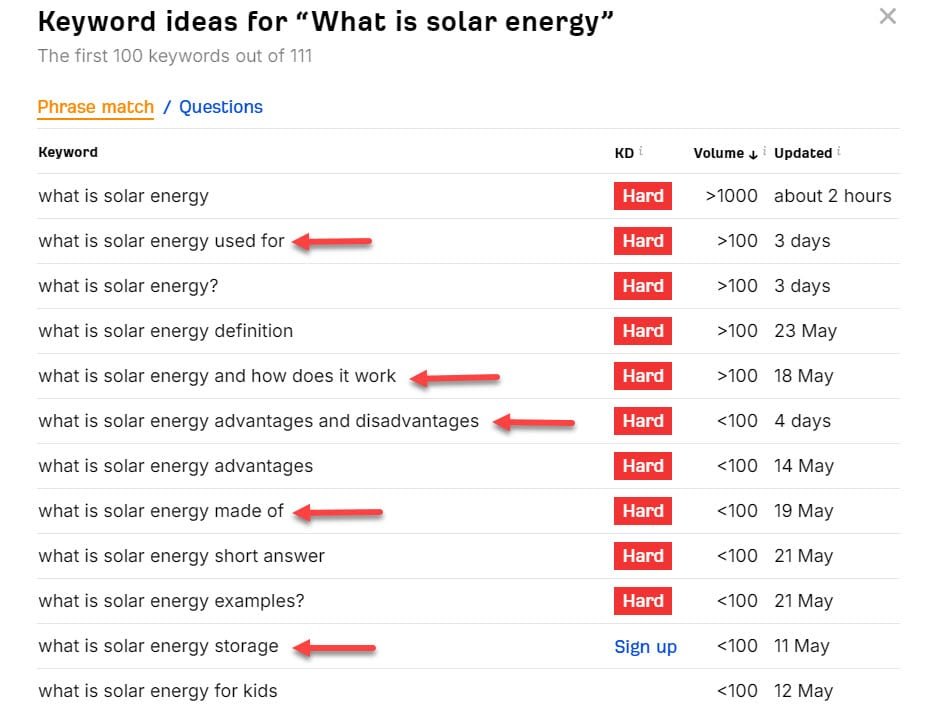
Next, google your topic and analyze the top 3-5 blog posts. Pay attention to what they discuss, how they explain concepts, and what kind of information they prioritize. You also need to identify gaps or missing information.
For example, are they missing details about the environmental impact of solar panels in [your audience country]? Did they not mention solar panel types best suited to the local climate? Did they share insights about local installation companies?
Look for outdated information, specific questions they didn’t mention, and the audience’s needs.
Tip:
Another tip is to look at the content's visual side. You can create infographics, videos, or other visual content to make the information more engaging and easy to understand.
3. Write High-Quality Content
Either write something worth reading or do something worth writing about.
Benjamin Franklin Tweet
This is a great way to think about the writing part of professional content writing. It means we should focus on making stuff that people enjoy reading and find useful.
This is where you, the content writer, turn your ideas into actual words on the page. It’s more than just typing though; you need to put together facts, interesting thoughts, and a bit of your own style.

When writing, you need to be clear, organized, and get to the point. You want to make sure your readers can easily understand easy and difficult ideas. To do this, you carefully choose your words and make sure your sentences flow well.
Try to keep the same “voice” or style throughout your writing, so it sounds like it’s coming from the same person or company.
Another good tip is to be creative. Add examples, jokes, personal stories, or questions that make readers think. For example, I’ve used more than seven examples in this post so far.

Readers also like reading first-hand experience. For instance, in his blog post titled ‘How to use AI to write a blog post,’ Lucca shared his prompts and good and bad results.

4. Edit and Proofread
Editing and proofreading are important steps in the content writing process. Before you share your writing with others, you need to tidy it up.
First comes editing. This is where you check the big things. Are all the ideas there? Do they make sense together? Is the writing clear and interesting? Check for appropriate tone and voice, and ensure consistency throughout.
Next, we focus on readability. We vary sentence lengths and use active voice to keep the writing lively and engaging. We also use transition words like “however” and “therefore” to smoothly connect ideas.
The last step is proofreading, checking for the little details. Are there any typos or spelling mistakes? Is the grammar correct? Does everything look neat?
Would you like a few proofreading tips?
Don’t try to proofread a whole document at once. Break it down into smaller sections and focus on one at a time. This can help you avoid getting overwhelmed and maintain your attention to detail.
You can use tools like Grammarly, ProWritingAid, or the Hemingway App to help you identify potential issues.
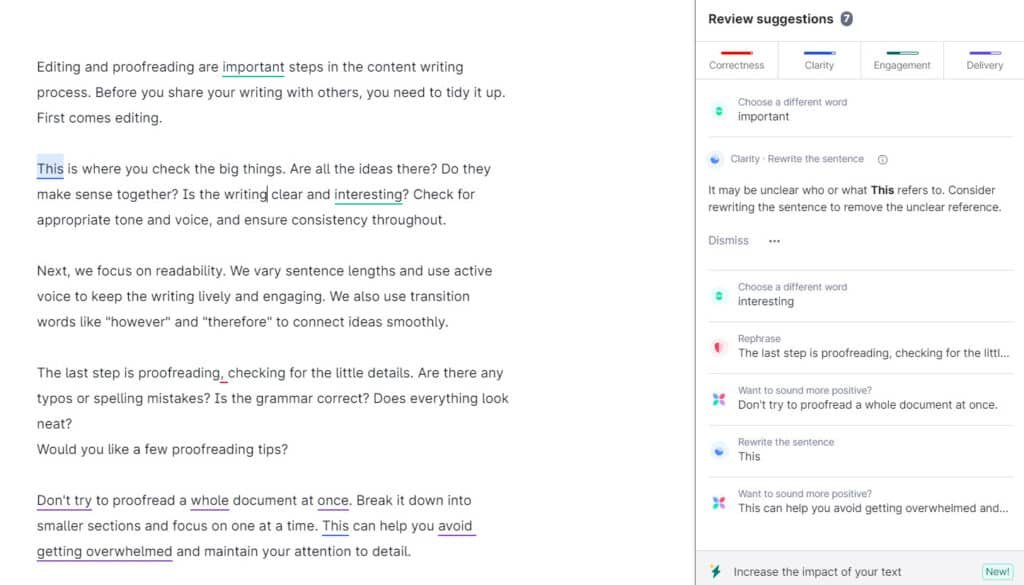
Another great tip is to ask a friend or colleague to read your work and provide feedback. They may catch errors you overlooked or offer suggestions for improvement.
Tip:
Once you’re done editing and proofreading your content, use a text-to-speech tool. Listen to your content being read aloud by the tool. This can help you identify awkward sentences, repetitive phrases, and unnatural-sounding dialogue. It's also a great way to catch missing words or punctuation errors that can disrupt the flow of the text.
Even the best writers need editing and proofreading. It’s how they make their writing clear, easy to read, and professional. So, don’t skip this step.
5. Format Your Content
The next step in the content writing process is formatting and optimization.
Images and videos make the content more interesting to look at. Think about the post you are reading now. It’s full of images or screenshots.
After how many words should you add an image?
There’s no strict rule. Try to add an image every 100-250 words depending on the type and length of your blog post, or wherever it makes sense.
A tutorial, for example, will require a lot of screenshots. A guide, however, will tend to follow the idea of using an image every 100-250 words.
Videos also add a personal touch through interviews or behind-the-scenes footage. They can also make complex ideas easier to understand, especially for visual learners.
6. Optimize Your Content
Now, let’s make sure people can find your amazing post online. If it’s a blog post, you’ll want to use the best SEO tips.
SEO stands for Search Engine Optimization. It’s the practice of making your blog post more attractive to search engines like Google, Bing, and Yahoo. The goal is to rank higher in search results when people search for relevant keywords or phrases.
For example, here is the result when I search for ‘hardest English words to pronounce.’ These posts were optimized to rank whenever people search for this keyword. Google then understood them and showed them to searchers.
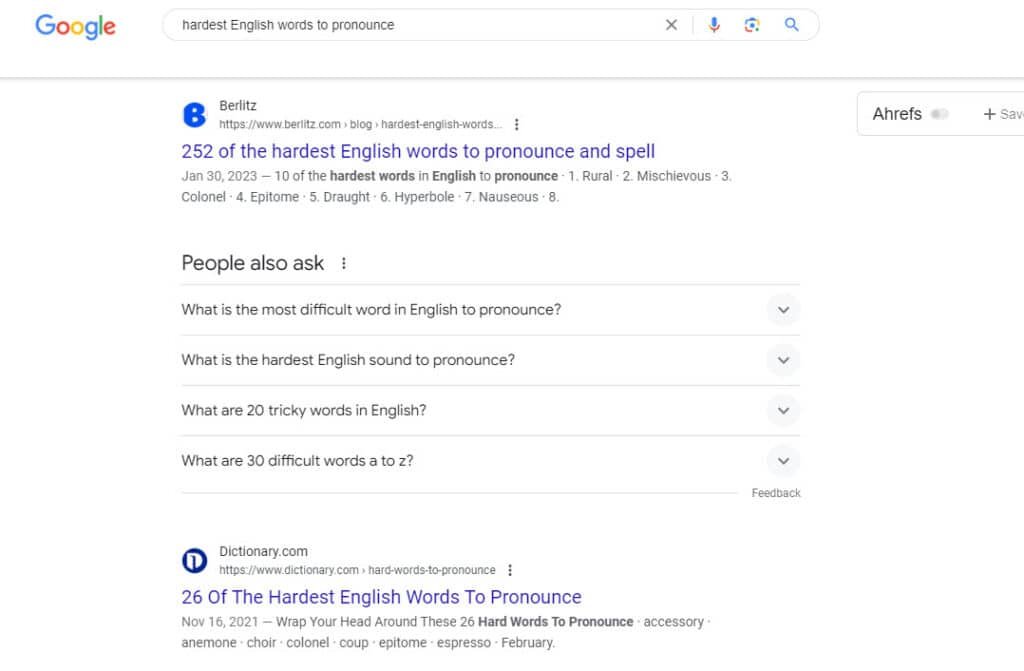
SEO is broad and is divided into multiple categories and On-page SEO is one of them. On-page SEO is optimizing the content on a page or article. You use keywords in the right places and optimize the headings, images, URLs, links, and more.
A good content writer must learn on-page SEO to write what readers and search engines like.
Also, your CMS may have options to do on-page SEO, like Rank Math and Yoast in WordPress.

Tip:
When you’re done writing, ask yourself this question from Google’s helpful content guideline: Does the content provide substantial value when compared to other pages in search results?
After all, our goal is to create better content than the competition.
6. Publish and Promote
Publishing and promoting your content is our last step.
First, you need to choose where to publish. This depends on the type of content and who you want to reach. It could be your website or blog, social media like Facebook or Twitter, emails to your subscribers, or even other websites related to your topic.
Next, it’s time to promote your content. Share it on social media, email it, or even pay for ads to reach more people. For social media, you can use this prompt in Gemini or ChatGPT:
“Write a 20-40 social media post promoting my new blog post titled “Add Your Title.” Use easy-to-understand language and emojis, ask thought-provoking questions, and make it sweet.“
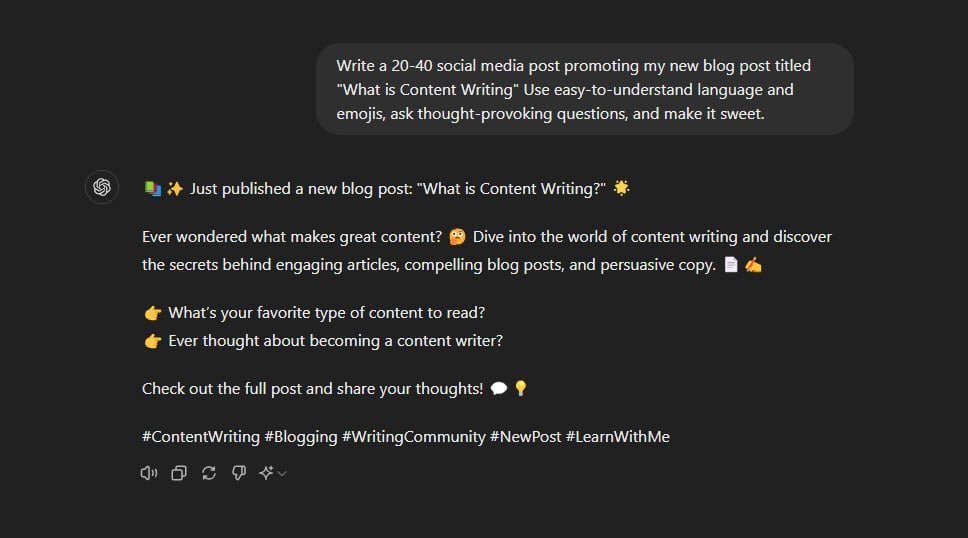
You can also team up with influencers – people who have a lot of followers online – to spread the word.
How about changing your content format, like turning a blog post into a video or podcast? Simply use AI video tools like Fliki or AI voice tools like ElevenLabs.
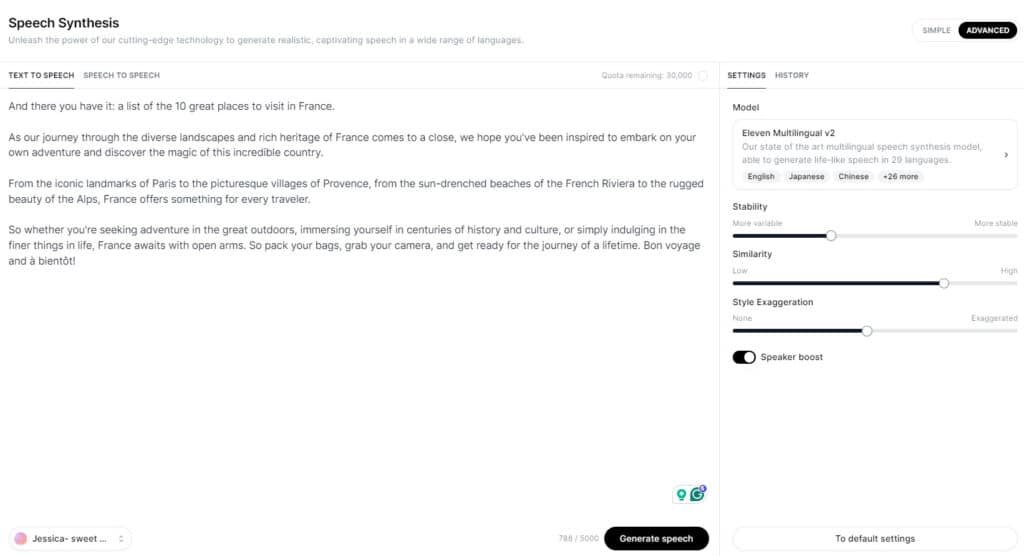
Lastly, remember to check how your content is doing. Google Analytics will show the number of people reading it and their engagement. This helps you understand what works and what doesn’t, so you can make your future writing even better.
How to Become a Content Writer
Now that you know the content writing process, you may want to know how to become a content writer. Here are the steps to take:
- Learn Content Writing and Hone Your Skills
- Specialize in a Niche
- Understand Your Audience
- Master SEO
- Build Your Portfolio
- Join Freelancing Platforms and Work for Companies
- Learn from the Best
- Get Feedback and Improve.
Let’s check each step in more detail.
1. Learn Content Writing and Hone Your Skills
To become a great content writer, you need to learn and develop strong writing skills. These skills are the foundation of creating engaging and effective content.
Learning content writing is forever, but there are some key steps to get going:
Build your foundation: First, grasp the core ideas of content writing. This means learning about different content types (like blogs, articles, or social media posts), who you’re writing for (your audience), and why SEO (Search Engine Optimization) is important.
Practice, practice, practice: The more you write, the better you’ll be. There are many ways to practice, like starting a blog, writing guest posts on other sites, or joining online writing communities.
Furthermore, make sure your grammar and spelling are accurate. Then, build your vocabulary and find your own writing style.
2. Specialize in a Niche
As a content writer, it’s easy to feel overwhelmed and try to write about anything and everything. But narrowing your focus and specializing in a specific niche can be a game-changer.
Think of it like choosing a major in college – it allows you to dive deep into a subject you’re passionate about.
When you specialize, you become an expert in your chosen field. You’ll understand your audience’s needs, preferences, and language like the back of your hand. This knowledge will help you craft content they like. Moreover, you can become a sought-after writer in that niche.
Specialization also helps you stand out from the crowd. It shows that you have a deep understanding of a specific topic. Companies will be ready to pay more to hire you.
Then, after months or years in one niche, you can expand by adding another one to your portfolio.
3. Understand Your Audience
To become a successful content writer, it’s crucial to understand your audience.
If you don’t know who you’re talking to, it’s difficult to say the right things. Similarly, it’s hard to create content your audience likes if you don’t know them.
What does it mean to understand your audience?
It means knowing their interests, what they like to read, and what kind of information they find valuable. What are their pain points? What solutions are they looking for? Once you know this, you can tailor your content to their needs.
For example, if you’re writing for tech-savvy people, you can use technical jargon and assume a certain level of knowledge. However, if you’re writing for a general audience, you’ll need to explain things more simply and avoid complex terms.
4. Master SEO
The next thing you need to do as a content writer is to master SEO (Search Engine Optimization).
SEO is an ongoing process, and search engines constantly update their algorithms. You’ll be left behind if you can’t keep up with the latest news.
For example, on May 14th, 2024 at Google I/O, Google announced a broader rollout of SGE, renaming it to AI Overviews. AI Overviews are AI-generated summaries that appear at the top of Google’s search results page for certain queries.
Here are a few resources to help you learn and become an SEO expert:
|
YouTube Channels
|
Blogs
|
SEO Courses
|
|---|---|---|
5. Build Your Portfolio
A portfolio shows potential clients what you can do. Imagine you’re applying for a job as a chef – you wouldn’t just say you’re good at cooking, right? You’d show off photos of your delicious dishes. A writing portfolio is the same idea: it’s proof of your abilities.
What to put in your portfolio?
The best pieces in your portfolio are samples that show the kind of writing you want to be hired for. If you want to write blog posts, include a few amazing blog posts. If you dream of crafting website copy, show off some snappy web pages you’ve written. You don’t need a ton of samples to start, just a few that demonstrate your skills.
How to get samples?
Don’t have any published work yet? No problem! Write some pieces specifically for your portfolio. You can:
- Write for Yourself: Start a blog or website and publish your own articles.
- Volunteer: Offer to write for a non-profit or community organization.
- Write Spec Pieces: Create sample pieces based on the types of projects you'd like to get hired for.

A portfolio isn’t a one-and-done project. As you gain more experience, keep adding new samples and updating your old ones. The goal is to make your portfolio a living document that shows the best of your writing abilities.
6. Join Freelancing Platforms and Work for Companies
If you dream of being a great content writer, freelancing platforms can be a huge help. Think of them like online job boards where companies and individuals post projects they need help with. By joining platforms like Upwork, Fiverr, or Freelancer, you get to see tons of different writing opportunities.
When you’re starting out, you might take on smaller, simpler projects to get experience and feedback. As you improve, you can tackle bigger challenges and work with more established clients.
How Much Should You Charge Per Word?
There’s no single answer to this question, as it depends on several factors. However, here’s a general guideline for per-word rates:
- Beginner: $0.02 - $0.10 per word
- Intermediate: $0.11 - $0.25 per word
- Experienced: $0.26 - $1.00+ per word
Keep in mind that these are just averages, and you may find yourself charging more or less depending on the specific circumstances. It’s also common for writers to charge a flat fee per project instead of a per-word rate, especially for larger or more complex projects.o.
7. Learn from the Best
In content writing, there’s no shame in learning from the masters. By reading, watching, and analyzing the work of successful content creators, you can immensely improve your own writing skills.
For instance, in this video, Matt Digitty, an SEO expert, shares his SEO strategy for 2024. Watching such content helps improve your skills.
When reading high-quality content, pay close attention to the structure, flow, and style.
Notice how they hook the reader in the beginning, maintain interest throughout, and leave a lasting impression. Observe how they use language, tone, and voice to connect with their audience.
Also, don’t be afraid to experiment and try different approaches. You might find that certain techniques work better for you than others. Remember, the goal isn’t to copy someone else’s style but to develop your own unique voice while drawing inspiration from the best.
8. Get Feedback and Improve
Imagine you’re baking a cake for the first time. You follow the recipe, but you’re not sure if it tastes right. You ask a friend to try it, and they tell you it needs more sugar. That’s feedback! It helps you improve your cake.
The same goes for writing. When you’re learning to be a content writer, feedback is super important. It helps you see what you’re doing well and what you can improve on.
How to Get Feedback That Helps
There are many ways to get feedback. You can ask friends, family, or colleagues to read your work. You can also join online writing groups or forums. Many of these have members who are happy to give feedback.
Even better, you can find a writing mentor or coach. They’re experienced writers who can give you personalized advice.
Finally, when you get feedback, don’t be afraid of it! See it as a gift. Read it carefully and try to understand what the person is saying. Don’t get defensive if they point out areas where you can improve. Instead, use their advice to make your writing even better.
You Can Learn Content Writing
To wrap things up, content writing is a really important part of the online world. It’s about telling interesting stories, giving people useful information, and getting them to do something. Learning how to write good content can help you reach the right people and get the results you want.
So, don’t be afraid to start writing – there are so many exciting things you can do with words!
FAQ on Content Writing
Content writing is basically creating written stuff that you see online. This could be blog posts you read, social media captions, words on websites, or even scripts for videos. It’s all about sharing information, telling stories, or trying to get people interested in something.
To be a good content writer, you need to have a few important skills, like writing, research, editing and proofreading, creative thinking, adaptability, SEO knowledge, organizational skills, communication, and time management.
You can find content writing jobs on websites like Upwork, Fiverr, or Freelancer. You can also try reaching out to companies directly or searching on social media platforms like LinkedIn.
As a beginner, you can charge between $0.02 – $0.10 per word, $0.11 – $0.25 per word as an intermediate, and $0.26 – $1.00+ per word as an experienced writer. How much you can earn as a content writer depends on your experience, the kind of content you write, and who you work for.
Some content writing mistakes to avoid are: 1. not understanding your target audience, 2. lack of planning and structure, 3. using overly complicated language, 4. ignoring SEO best practices, 5. not providing value to the reader, and 6. inconsistent tone and style.
The best content writing service providers are Ranklyx, Verblio, Crowd Content, and Express Writers.

Piaff Dibota
Increase Your SaaS Traffic & Sales with Top Content Marketing!
Content without strategy is just noise. We build high-impact content that aligns with your goals, targets your ICP, and increases revenue.

